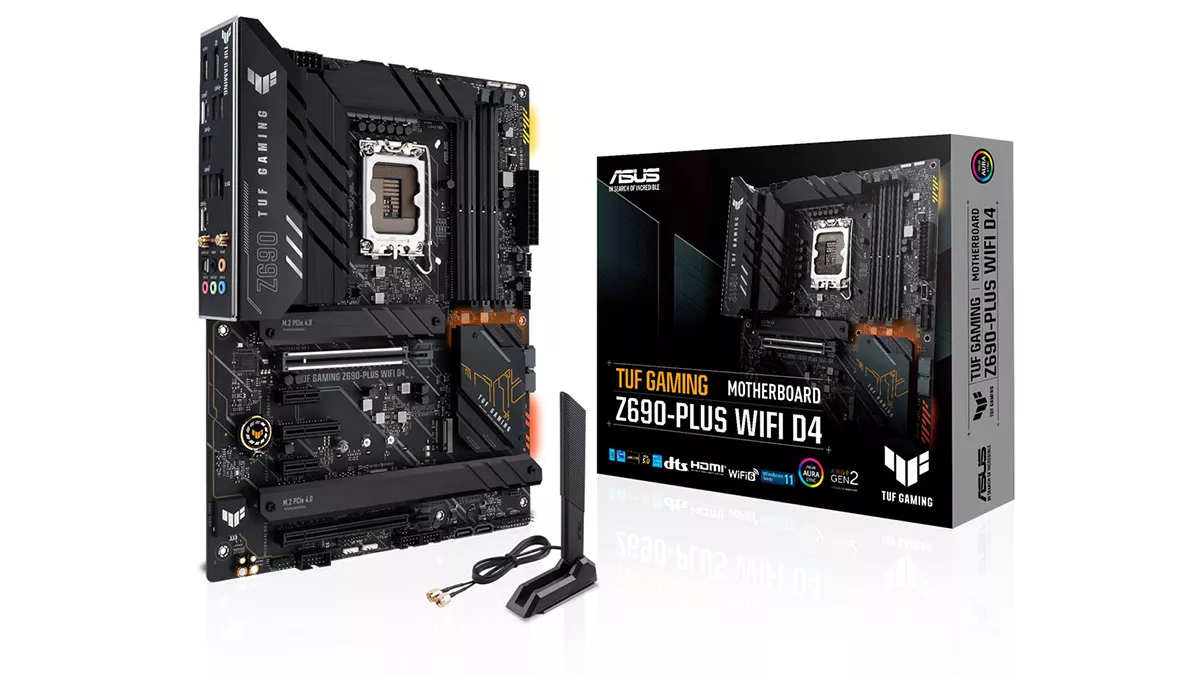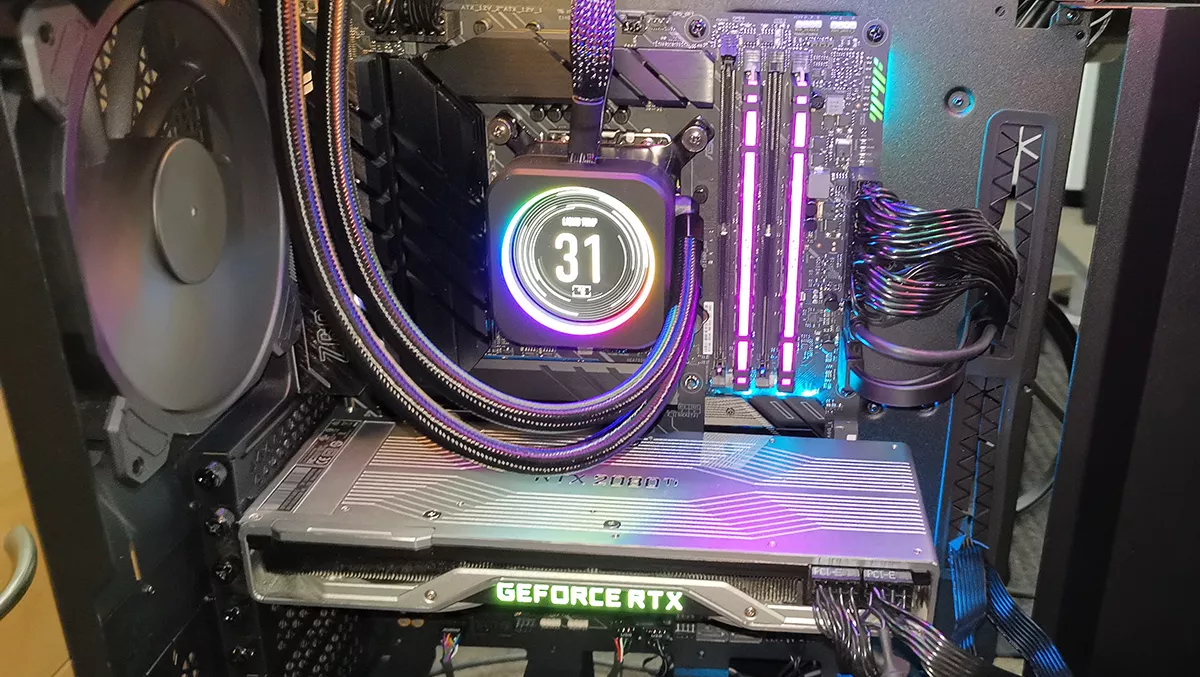
Hands-on review: ASUS TUF Gaming Z690-PLUS WIFI D4 motherboard
Asus aims to make upgrading to an Intel 12th generation Alder Lake CPU a little easier on your pocket with the TUF Gaming Z690-PLUS WIFI D4 motherboard.
For Intel's Alder Lake CPUs, it's all change. Unlike previous iterations, there's no stuffing the new Intel CPUs into your old motherboard and make do until you can afford to replace it. These new CPUs have a completely different pin configuration requiring a motherboard with the new LGA 1700 socket.
If you have an older CPU cooler, chances are you will have to replace that as well as the CPU sits at a different height to past arrangements. Intel's new chips are also designed with DDR5 memory in mind.
Unfortunately, DDR5 DRAM modules are hard to come by at the moment, and if you do find them, they are very expensive. You'll be paying through the nose for RAM that's likely to not give you bang for your buck for the moment.
Currently, only motherboards based on the Z690 chipset are available for Intel's Alder Lake CPUs. So, we are paying a premium until the likely release of motherboards based on Intel's H and B prefixed chipsets.

The Asus TUF Gaming Z690-PLUS WIFI D4 motherboard is a feature-rich board that is a bit easier on the pocket than many Z690 boards. It uses DDR4 memory so, if upgrading, you may still be able to use your existing memory. Also, if buying some DDR4 new, you will not be paying anything like the current cost of DDR5 modules (if you can find any).
The board supports up to 128GB of DDR4 DIMMs across four sockets running at a maximum of 5133MHz.
This is my first time using one of Asus's TUF motherboards. Of Asus's three gaming motherboards brands, TUF, Strix, and Maximus, TUF is considered the "entry-level" gaming motherboard marque.
Traditionally they are designed using robust components, but for the more mainstream gamer rather than the enthusiasts that the Strix and Maximus boards are marketed towards. They are also a bit cheaper, although all the Z690 motherboards seem to have a bit of a markup this time out.
Reading through the specifications of the TUF Gaming Z690-PLUS WIFI D4, I was pleasantly surprised. The board has a rather uncompromising set of features that I'd expect on a much more expensive motherboard and more than adequate for most users.
Regarding Intel's 12th-Gen Alder Lake CPUs, whilst I'm still evaluating their performance, initial signs suggest that they are a significant improvement over previous iterations of Intel chips. I wasn't overly impressed with the 11th-Gen performance over the 9th-Gen CPUs.
The 12-Gen utilities two types of core, performance cores (P-Cores) for the heavy lifting and efficiency cores (E-Cores) for background tasks. In a real-life test, I found that the new Intel i5-12600K CPU outperforms a 10th-Gen i9-10900K.
The Asus TUF Gaming Z690-PLUS WIFI D4 motherboard can accommodate four fast M.2 NVMe SSDs at data transfer speeds of up to 7.88 GB/s with a Gen 4 NVMe drive. One of the slots can also accommodate the slower M.2 SATA SSD drives.
There are eight USB ports on the rear I/O panel, including one USB 3.2 Gen 2x2 Type-C port capable of speeds of up to 20Gbps. Two of the ports are 10Gbps USB 3.2 Gen 2 Type-A, the rest being 5Gbps USB 3.2 Gen 1. The motherboard also has headers for seven more optional external USB ports.
The board does not support Crossfire/SLI GPU configurations, which have pretty much gone the way of the dodo, anyway. There's a reinforced PCIe 5.0 x16 slot for a graphics card.
There are two PCIe 3.0 x1 slots, one PCIe 3.0 x4 slot, and another full-length PCIe 4.0 x16 slot. That's enough sockets to accommodate all your expansion card needs, be it additional SATA sockets, USB ports, soundcard, or even a Thunderbird 3 expansion card (using the TB header on the motherboard).
Also of note is the latest Wi-Fi 6 wireless networking capabilities and the 2.5 Gb Ethernet socket for wired network connections. The 7.1 Realtek audio, featuring AI noise reduction, rounds off the main features of the motherboard.
With plenty of room for expansion, I found nothing missing from this board. I can't see the average user (or enthusiast user) running out of upgrade opportunities with this board.
The board itself has some heft to it. It feels robust (TUF, even). Asus has put a few extras on their board, making them easy to install and set up for novice builders.
Rather than using fiddly little screws to hold the M.2 SSDs in place, they have plastic latches that rotate and hold the drives in place.
There are also some additional LED indicators to help troubleshoot issues with the CPU, display, RAM, or boot-up. I had a boot problem that I easily traced to a memory module (fixed by removing it, blowing out the slot with some air and reseating). The RAM LED pointed me right to the source of the issue, enabling me to resolve the problem quickly.
I really like the Asus UFEI BIOS. This is the menu system used to fine-tune the PC's configuration and what you are prompted to enter when first switching on if you are building it yourself. If you buy a PC with this motherboard in a shop, the technicians will have already configured this for and installed Windows.
The BIOS has two menu layouts defaulting to a simplified page with everything you need to get going. The display shows fan speeds, the memory XMP setting (which needs to be switched on to type I to get the memory running at the speed you paid for), and some one-touch overclocking settings.
If you are using an unlocked CPU with a "K" suffix, and you have a decent CPU cooler, I'd encourage you to switch the AI Overclock setting to at least the fast tuning and maybe even the extreme tuning mode for an extra performance boost. If that works without issue, you could also try extreme tuning. I got an additional 9% of CPU performance out of the CPU by adjusting this setting. More confident users can switch to the advanced view for comprehensive control over the motherboard functions.
The board comes with a few accessories, such as the Wi-Fi antenna, SATA cables, a comprehensive and easy-to-read manual, and a driver/utility disk. If you've not got a DVD drive in your machine, you can download all the drivers and software from the Asus website (I'd recommend this to be honest, as it'll be more up-to-date).
The Asus TUF Gaming Z690-PLUS WIFI D4 motherboard is a lot of board for only a modest investment. It enables users to e get up and running with Intel's 12th-Gen CPUs without investing in the hard-find-find and ridiculously priced DDR5 memory modules.
At the same time, though, the board makes no compromises, offering some fantastic features on par with motherboards at twice the price.


